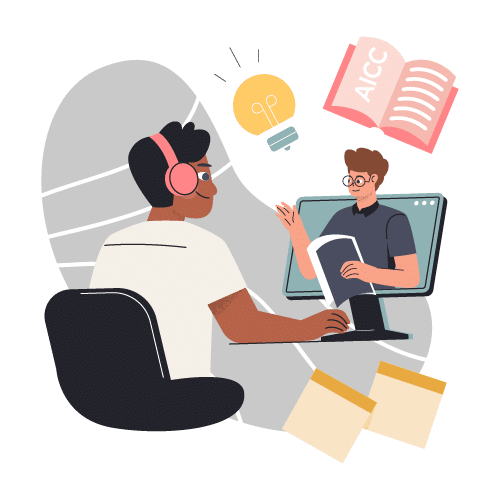Have you ever taken an online course that left you frustrated and confused? Maybe the content was outdated, the navigation was confusing, or the assessments didn’t align with the learning objectives.
These issues are not uncommon in eLearning courses, and they can have a significant impact on the learners’ experience and the effectiveness of the course.
This is where Quality Assurance (QA) comes in.
QA is the process of verifying that a product or service meets the required standards of quality before it is released to the market. In the context of eLearning, QA ensures that the course content, design, and functionality are of high quality and aligned with the learning objectives and audience needs.
QA is a crucial part of the eLearning development process. Without it, learners may struggle to engage with the course content, leading to low completion rates and ineffective learning outcomes. A well-designed and thoroughly tested eLearning course, on the other hand, can improve learner engagement, retention, and knowledge transfer.
So, what are some of the key aspects of QA in the eLearning development process? Let’s take a closer look at some of the checklist items that one might use to ensure that their eLearning courses are of high quality.
Content Accuracy
Content accuracy is crucial in any eLearning course. Learners need to trust that the information they are receiving is factual and up-to-date. A course that contains outdated or incorrect information can have a negative impact on the learners’ confidence in the course content and the organization providing it.
To ensure content accuracy, instructional designers should verify that all information in the course is factually correct and up-to-date. They should also ensure that the learning objectives are clearly stated and addressed in the course.
Finally, they should make sure that all information is relevant to the target audience.
Copyediting
When it comes to quality assurance, one critical aspect that often gets overlooked is copyediting.
Copyediting serves as the vigilant gatekeeper, ensuring that every word and sentence is polished to perfection. It goes beyond just fixing grammar and punctuation errors; copyediting is about crafting engaging and error-free content that resonates with the learners. A meticulous copyeditor scrutinizes every sentence, evaluating the clarity of the message, eliminating unnecessary jargon, and refining the overall tone to create a seamless learning experience.
By meticulously examining the text, a skilled copyeditor ensures that the instructional materials are not only accurate and coherent but also aligned with the learning objectives and the target audience’s needs. The copyediting process not only enhances the quality and professionalism of the content but also contributes to the overall effectiveness of the instructional design.
Instructional Design
Instructional design refers to the process of designing and developing learning experiences that are effective and engaging. A well-designed eLearning course can make a significant difference in the learners’ engagement and retention of the course content.
To ensure effective instructional design, instructional designers should check that the course structure is consistent and easy to follow.
They should also verify that the multimedia elements, such as images and videos, are used effectively to enhance learning. Finally, they should evaluate the effectiveness of interactive elements, such as quizzes or simulations, to engage learners.
Navigation and Usability
Navigation and usability are crucial aspects of any eLearning course. Learners need to be able to easily navigate the course and find the information they need. Confusing navigation or poor usability can lead to frustration and a negative learning experience.
To ensure effective navigation and usability, anyone performing QA should check that the course navigation is clear and easy to use, with a logical sequence of lessons and activities.
They should also verify that instructions for completing activities and assessments are clear and easy to follow. Finally, they should evaluate the use of hyperlinks and buttons for navigation, ensuring they are intuitive and consistent.
Accessibility
Accessibility refers to the ability of all learners to access and engage with the course content, regardless of their abilities or disabilities. An inaccessible course can exclude learners with disabilities and limit the potential reach of the course.
To ensure accessibility, consider adhering to the Web Content Accessibility Guidelines (WCAG) established by the World Wide Web Consortium (W3C). These guidelines provide a comprehensive framework for creating accessible digital content.
Designers should check that the course is compatible with screen readers and other assistive technologies, ensuring proper semantic structure and alternative text for images. They should also verify that all multimedia elements are accessible to all learners, including those with hearing or visual impairments, by providing captions, transcripts, and audio descriptions.
Furthermore, they should evaluate the use of color contrast and font size for readability, following WCAG guidelines to accommodate learners with visual impairments. By incorporating WCAG principles into the design process, you can create inclusive learning experiences that embrace diversity and provide equal access to all learners.
Brand Consistency
Maintaining brand consistency is a paramount aspect of quality assurance when it comes to eLearning design. Each client or organization has its own unique brand voice and style, which reflects its values, personality, and target audience. It is crucial to understand and adhere to these brand guidelines to ensure that the eLearning materials align seamlessly with the client’s overall brand image.
By carefully integrating the client’s brand elements, such as color schemes, typography, and tone of voice, into the eLearning design, we create a cohesive and immersive experience for the learners. Consistency in branding not only enhances recognition and credibility but also reinforces the learners’ connection to the organization.
Through effective quality assurance, we meticulously review and refine each element of the eLearning, ensuring that it embodies the desired brand voice and style, and ultimately delivers a unified and impactful learning experience.
Technical Functionality
Technical functionality refers to the ability of the course to function properly, without errors or bugs. A course with technical issues can disrupt the learners’ engagement and lead to frustration.
To ensure technical functionality, verify that the course is compatible with different browsers and devices, including mobile devices. They should also check that the course can handle user interactions, such as submitting assessments or asking questions.
Finally, they should evaluate the effectiveness of any third-party tools or plugins used in the course.
These are just a few examples of the checklist items you can use to ensure the quality of eLearning courses. Each item plays a crucial role in creating an effective and engaging learning experience for the learners.
Incorporating a QA checklist into the eLearning development process is like adding a safety net. It helps catch any issues or gaps in the course content, design, or functionality before it reaches the learners.
By addressing these issues early on, course creators can save time and resources and ensure that the final product meets the required standards of quality.
At the same time, it’s important to remember that the QA checklist is not a one-time activity. It should be an ongoing process throughout the course development cycle. Regular testing and reviewing of the course content and functionality can help identify and address any new issues that may arise.
Key Tips for Conducting a QA Review on Your eLearning Course
Quality assurance is crucial in ensuring that eLearning content is effective, user-friendly, and error-free. Here are some valuable tips to consider:
- Understand the Learning Objectives: Gain a clear understanding of the learning objectives and goals of the eLearning module. This will help you align your testing efforts with the desired outcomes.
- Test on Various Devices and Browsers: eLearning content should be accessible on a wide range of devices, including desktops, laptops, tablets, and smartphones. Test the content on various browsers and operating systems to ensure consistent functionality.
- Check for Responsiveness: Ensure that the eLearning module is responsive and adapts well to different screen sizes. Elements should be appropriately scaled and positioned to maintain readability and usability.
- Verify Interactivity: eLearning often involves interactive elements like quizzes, simulations, and multimedia. Test these interactions thoroughly to ensure they function as intended and provide accurate feedback to users.
- Assess User Navigation: Check the navigation flow of the eLearning module. Users should be able to intuitively move between sections, modules, and content pages. Verify that buttons, links, and menus work properly.
- Evaluate Multimedia Elements: If the eLearning content includes multimedia (videos, audio, animations), verify that they load correctly, have good audio-video synchronization, and play smoothly.
- Proofread Content: Typos and grammatical errors can undermine the credibility of eLearning content. Thoroughly proofread all text, captions, and instructions to ensure correctness and clarity.
- Test Assessments and Quizzes: Validate the accuracy of questions, answers, and scoring mechanisms in assessments and quizzes. Ensure that the grading system aligns with the learning objectives.
- Check Accessibility: eLearning content should be accessible to users with disabilities. Verify that it adheres to accessibility standards (such as WCAG) to accommodate users with visual, auditory, or motor impairments.
- Test Progress Tracking: If the eLearning platform tracks user progress, verify that it accurately records completed sections, modules, and assessments. Users should be able to resume where they left off seamlessly.
- Perform Browser Compatibility Testing: Different browsers can interpret code differently. Test the eLearning module across popular browsers to identify and resolve any compatibility issues.
- Simulate Real-World Scenarios: Try to simulate real-world scenarios that users might encounter. This can help you identify any usability issues or unexpected behaviors that might arise during actual usage.
- Use Emulators and Simulators: For devices you don’t have direct access to, consider using emulators and simulators to test different platforms and screen sizes.
- Regression Testing: Whenever updates or changes are made to the eLearning content, perform regression testing to ensure that new changes haven’t introduced new bugs or broken existing functionality.
- Collect User Feedback: After deploying the eLearning module, encourage users to provide feedback. This can help you identify issues that might not have been caught during testing and gather insights for continuous improvement.
Remember, the key to effective quality assurance in eLearning is meticulous testing, attention to detail, and a deep understanding of the learner’s perspective. By following these tips, you can help ensure that your eLearning content is of the highest quality and provides a valuable learning experience for users.
Achieve eLearning Excellence with Our Comprehensive QA Checklist
QA is an essential aspect of eLearning course development. It ensures that the course content is accurate, the instructional design is effective, and the course is accessible and functional for all learners. By incorporating a comprehensive QA checklist into the development process, you can deliver high-quality eLearning courses that engage learners, foster effective learning outcomes, and make a positive impact on the learners’ educational journey.
To help you ensure the quality of your eLearning courses, we’ve created a comprehensive QA checklist that covers all the important aspects we discussed in this blog post. It’s a valuable resource that you can use as a guide throughout your course development process.
Don’t miss out on this opportunity to enhance the quality of your eLearning courses! Click the link below to download our free QA checklist:
By implementing the items on this checklist, you’ll be able to catch any issues or gaps in your courses and create a seamless and engaging learning experience for your audience.
Remember, QA is an ongoing process, so make sure to revisit and update your checklist regularly to align with industry standards and emerging best practices.
If you have any questions or need further assistance, feel free to reach out to us. We’re here to support you in delivering top-notch eLearning experiences.






